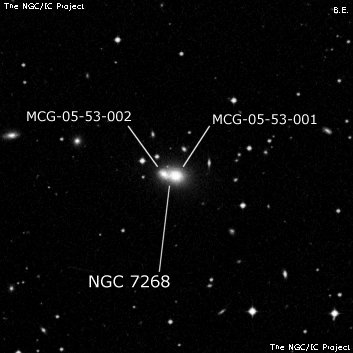
John Herschel discovered NGC 7268 = h3939 on 28 Sep 1834 and recorded "vF, S, R." He added the comment "The preceding of 2 [with NGC 7277]." At his position (mean of two observations) is the double galaxy ESO 467-057. His GC position, which was used in the NGC, is 1.0 minute of RA too far west.
The RNGC clearly misidentifies NGC 7268 (the position is 3' south of ESO 467-IG55) and NGC 7268 is plotted too far south on the first version of Uranometria 2000 Atlas. Listed in my RNGC Corrections #5 and Corwin's notes.
The 2 components of this merged double system are identified as NGC 7268A (west) and NGC 7268B (east) in the SGC.
400/500mm - 17.5" (10/5/91): very faint, very small, round. A wide double star mag 14/15 is 1' NE. Slightly brighter of a pair with NGC 7277 7.2' ENE.
600/800mm - 24" (9/6/18): at 375x; NGC 7268 is a merged double system at 20" separation between centers, with NGC 7268 NED1, the brighter and larger component, on the west end and NGC 7268 NED1 on the east end. Initially the combined glow appeared fairly faint, fairly small, elongated ~3:2 E-W, ~0.6'x0.4', slightly brighter nucleus. With careful viewing, the fainter and smaller eastern member occasionally resolved as a distinct glow; faint, very small, round, 12"-15" diameter. The halos of the two components appeared merged with no gap. NGC 7277 lies 7.2' NE.
Notes by Steve Gottlieb